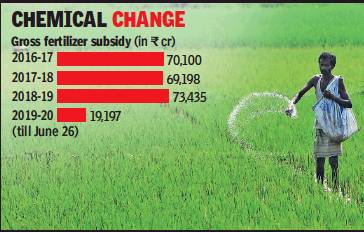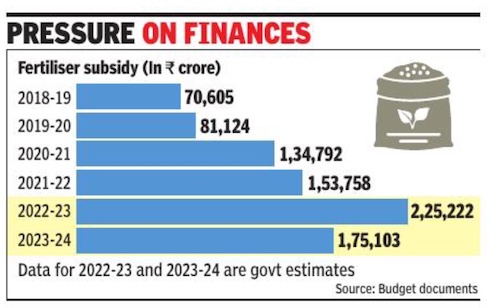Fertilisers: India
This is a collection of articles archived for the excellence of their content. |
Contents |
Chemical fertilisers
Usage: Punjab top user 2023-24
The use of chemical fertilisers per hectare in Punjab is around 77% more than national average, govt informed RS Tuesday. In a written reply, fertiliser ministry said in 2023-24, “total nutrient per hectare” consumption in Punjab was 247.6kg compared to national average of 139.8kg. TNN
Fertiliser use, subsidy
2016-19
Dipak Dash, July 14, 2019: The Times of India

From: Dipak Dash, July 14, 2019: The Times of India
Currently, farmers are allowed to buy as much fertilizer as they want at subsidised rate and its based on a “no denying” policy. The government directly pays the subsidy amount to manufacturers or marketing firms. The annual subsidy outgo for fertilizer was Rs 70,000 crore in 2016-17, over Rs 69,000 crore in 2017-18 and Rs 73,435 crore in the last financial year. Till June-end, the subsidy outgo in the current fiscal year was Rs 29,000 crore.
2013-21

From: Dec 1, 2021: The Times of India
See graphic:
The government of India’s Fertiliser subsidy, 2013-21
2018- 24

From: Dipak Dash & Sidhartha, Feb 13, 2023: The Times of India
See graphic:
Fertiliser subsidy provided in India, 2018- 24
2019-23: subsidy and types of fertiliser used
Dipak Dash, Oct 26, 2023: The Times of India

From: Dipak Dash, Oct 26, 2023: The Times of India
New Delhi : The Union cabinet approved Rs 22,303 crore subsidy for nutrient-based phosphatic and potassic (P&K) fertilisers for the current Rabi season starting October 1. With global prices cooling down, the proposed outgo towards fertiliser subsidy will be 57% lower than the last Rabi season and 31% less than the Kharif season, which ended in September.
The Centre’s fertiliser subsidy had shot up to a record of more than Rs 2.5 lakh crore last year following the spike in international prices in the wake of the war in Ukraine. The government had decided to absorb the increase in costs.
Even this year, there will be no change in prices and farmers will get urea bags at Rs 266, di-ammonium phosphate (DAP) at Rs 1,350, NPK at Rs 1,470 and single super phosphate at Rs 550. The price of potash (MOP) will be Rs 45 lower at Rs 1,655 compared to Kharif. “The government is providing the subsidy so that there is no extra burden on farmers... Subsidies will continue because when international prices rise the government doesn’t want it to impact our farmers in the country,” I&B minister Anurag Singh Thakur told reporters. During the last Rabi season, the government had approved a subsidy of Rs 51,875 crore and for the Kharif season this year, it had provided Rs 38,000 crore.
The average international price of DAP fell to $540 per tonne in August, 39% lower than the earlier peak of $891 a tonne exactly a year back. Similarly, the international price of urea fell 44% to $374 per tonne in August compared to $665 per tonne in October last year. Prices have gone up over the last two months, an official said, with out disclosing the data. “The overall subsidy figure may change as it depends on the international prices. So far, we have utilised around 54% of the budgeted subsidy for the current financial year,” said an official. The government has allocated Rs 1.75 lakh crore subsidy for 2023-24.